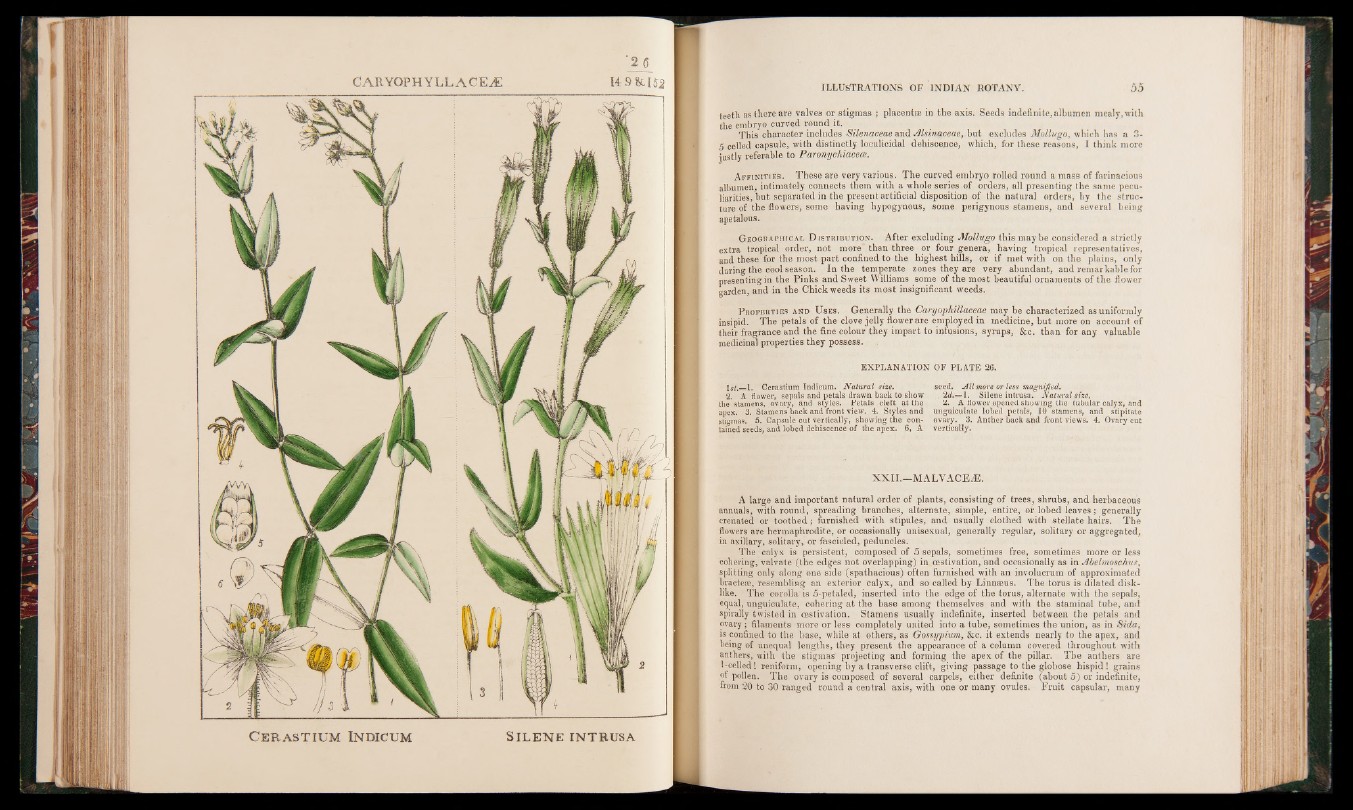
teeth as there are valves or stigmas ; placentae in the axis. Seeds indefinite,albumen mealy,with
the embryo curved round it.
This character includes Silenaceae and Alsinaceae, but excludes Mollvgo, which has a 3-
5 celled capsule, with distinctly loculicidal dehiscence, which, for these reasons, I think more
justly referable to Paronychiacece.
Af fin it ie s. These are very various. The curved embryo rolled round a mass of farinacious
albumen, intimately connects them with a whole series of orders, all presenting the same peculiarities,
but separated in the present artificial disposition of the natural orders, by the structure
of the flowers, some having hypogynous, some perigynous stamens, and several being
apetalous.
G eographical D istribution. After excluding Mollugo this maybe considered a strictly
extra tropical order, not more than three or four genera, having tropical representatives,
and these for the most part confined to the highest hills, or if met with on the plains, only
during the cool season. In the temperate zones they are very abundant, and remarkable for
presenting in the Pinks and Sweet Williams some of the most beautiful ornaments of the flower
garden, and in the Chick weeds its most insignificant weeds.
P roperties and U s e s . Generally the Caryophillaceae may be characterized as uniformly
insipid. The petals of the clove jelly flower are employed in medicine, but more on account of
their fragrance and the fine colour they impart to infusions, syrups, &c. than for any valuable
medicinal properties they possess.
EXPLANATION OF PLATE 26.
Is/.—1. Cerastium Indicum. Natu ra l size.
2. A flower, sepals and petals drawn back to show
the stamens, ovary, and styles. Petals cleft at the
apex. 3. Stamens back and front view. 4. Styles and
gticrmas. 5. Capsule cut vertically, showing the contained
seeds, and lobed dehiscence of the apex. 6, A
seed. A ll more or less magnified.
. 2 d.—1. Silene intrusa. Na tu ra l size,
2. A flower opened showing the tubular calyx, and
unguiculate lobed petals, 10 stamens, and stipitate
ovary. 3. Anther back and front views. 4. Ovary cut
vertically.
XXII.—MALVACE/E.
A large and important natural order of plants, consisting of trees, shrubs, and herbaceous
annuals, with round, spreading branches, alternate, simple, entire, of lobed leaves; generally
crenated or toothed; furnished with stipules, and usually clothed with stellate hairs. The
flowers are hermaphrodite, or occasionally unisexual, generally regular, solitary or aggregated,
in axillary, solitary, or fascicled, peduncles.
The calyx is persistent, composed of 5 sepals, sometimes free, sometimes more or less
cohering, valvate (the edges not overlapping) in (estivation, and occasionally as in Abelmoschus,
splitting only along one side (spathacious) often furnished with an involucrum of approximated
bracteae, resembling an exterior calyx, and so called by Linnaeus. The torus is dilated disklike.
The corolla is 5-petaled, inserted into the edge of the torus, alternate with the sepalsj
equal, unguiculate, cohering at the base among themselves and with the staminal tube, and
spirally twisted in oestivation. Stamens usually indefinite, inserted between the petals and
ovary; filaments more or less completely united into a tube, sometimes the union, as in Sida,
is confined to the base, while at others, as Gossypium, See. it extends nearly to the apex, and
being of unequal lengths, they present the appearance of a column covered throughout with
anthers, with the stigmas projecting and forming the apex of the pillar. The anthers are
1-celled! reniform, opening by a transverse clift, giving passage to the globose hispid! grains
of pollen. The ovary is composed of several carpels, either definite (about 5) or indefinite,
from 20 to 30 ranged round a central axis, with one or many ovules. Fruit capsular, many